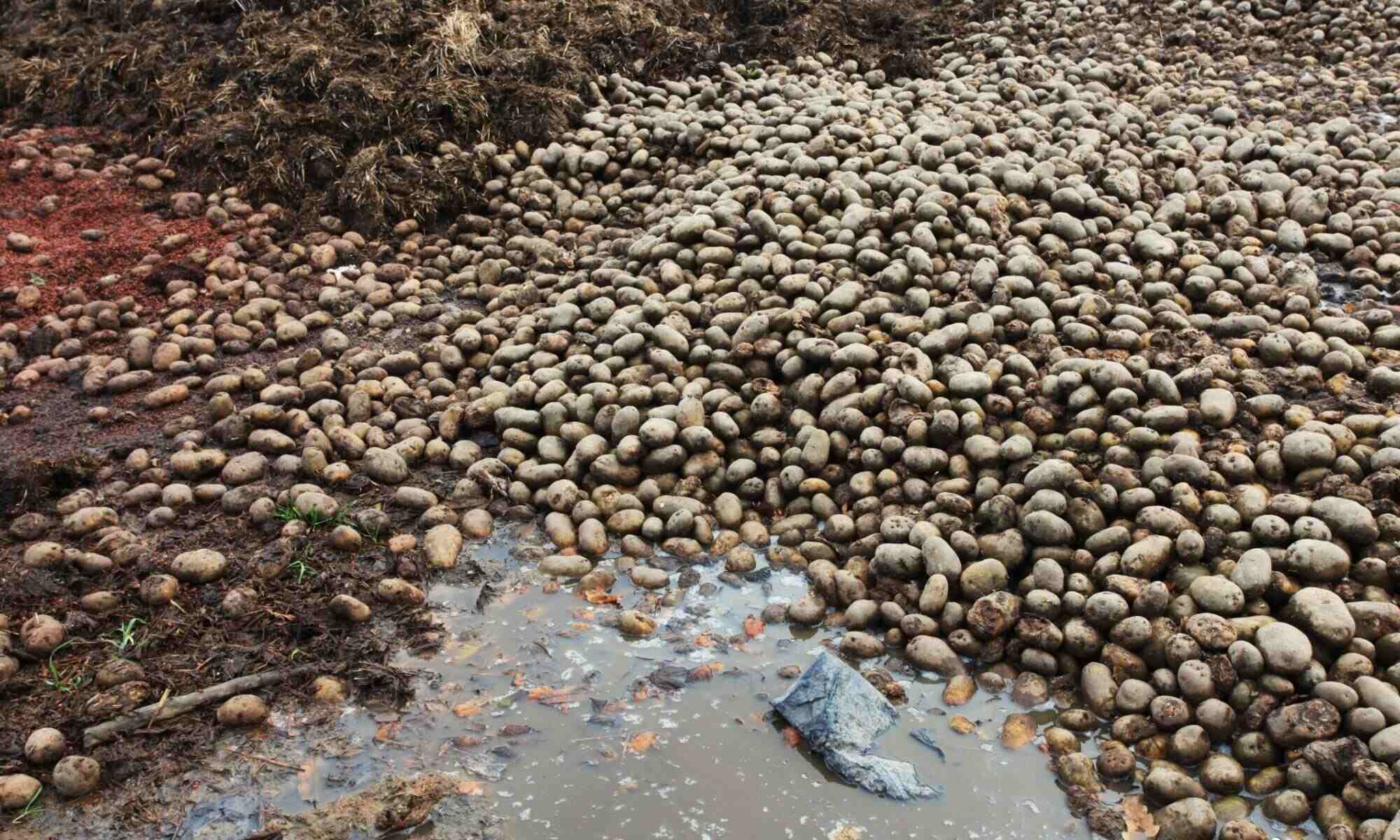The Earth is haemorrhaging with food waste. We produce far more food than we can consume, even as one in nine people—that's between 720 and 811 million people worldwide—are undernourished.
Shockingly, if food waste was a country, it would be the third biggest greenhouse gas emitter, behind the USA and China, producing more emissions than the entire aviation industry. A widely shared estimate is that globally, we waste one-third—roughly 1.3 billion tonnes—of all food and drink produced. However, this much-shared estimate is probably incorrect—a recent study concluded that the actual amount of consumers’ global food waste is likely to be significantly higher.
Population growth and the expansion of the middle class across the globe means the wastage is set to increase, even as governments and food industries seek greater efficiency in infrastructures and consumers themselves seek to reduce their food waste footprint. A promising though imperfect solution involves exploiting the natural digestion process of microbes to convert food and other organic waste into a relatively clean energy that can be harnessed at scale by cities or by off-grid communities and residential households. Bioinnovation in this process is occurring at speed, encouraging startups, organisations and independent communities to promote biogas and biomethane as crucial elements in reducing the social, economic and environmental harm of decaying food.
The scale and environmental harm of the global food waste problem
In 2019, global food waste at retail, service and households accounted for an estimated 931 million tonnes, according to the United Nation’s Environmental Food Waste Index. To help put that into perspective, one tonne of food waste would require 127 large plastic bin bags. The report notes that Nigeria sheds a whopping 189 kilograms per capita, Greece 142 kilograms and the United Kingdom 77 kilograms per capita, near the global average of 74 kilograms.
Household wastage by consumers accounted for over 60 percent of the United Nation’s figure and was roughly stable in countries across income divides. The global household wastage is above earlier estimates, which had put most of the loss during production, distribution, manufacturing and retail. Lower-income countries still shoulder the burden of food loss during production, distribution and manufacture because of infrastructure and supply chain inefficiencies. Yet, households in higher-income communities contribute greater levels of voluntary wastage as discarded edible food, as compared to lower-income countries that produce more involuntary household waste by way of inedible bones, pits and shells and challenges associated with storing and preserving food. As a reminder that higher-income societies are integral to combating wastage, consider that they throw away as much food each year as the whole of sub-Saharan Africa produces.
Squandered food is a serious contributor to climate change, through the release of avoidable greenhouse gases. According to Project Drawdown, a world-leading resource on climate change, reducing food waste by 50–75 percent by 2050 would avoid 13.6–26 gigatons of carbon dioxide emissions. Uneaten food leads to unnecessary deforestation, water and biodiversity loss and increased food insecurity. It also burdens waste management systems and creates needless associated greenhouse gas emissions during food storage, transportation and refrigeration. The mass production and consumption of food for humans and animals, combined with increasing population growth, has disrupted the cyclical processes of nature in which organic materials break down into nutrients to feed the next generations of plants and animals. Industrial food production has created a linear path from the production and consumption of food into sterile and problematic waste.
Discarded food is routinely dumped in landfills or burnt in incinerators. In the USA, over 55 percent of food waste ends up in landfills. Landfills are one of the worst places for rotting food as they exacerbate the release of harmful greenhouse gases as it decomposes. According to the American Environmental Protection Agency (EPA), food waste drives 18 percent of the methane emissions in the United States’ landfills, with 15.1 percent of total methane emissions originating from food waste in landfills. Methane leaking from food waste is 21 times more destructive than carbon dioxide. The unnaturally oxygen-free environment of most landfills exacerbates the damage, delaying the breakdown of organic waste and releasing harmful gas emissions. A single head of lettuce, for example, may take up to 25 years to decompose in a landfill, giving off toxic methane gas the entire time—an inefficient, slow and damaging process.
Most countries have inefficient food waste management systems. In the last 20 years, the social, economic and environmental costs of food wastage and loss have received attention from the United Nation and member states. The United Nation’s Sustainable Development Goal aims to halve global consumer food loss and wastage per capita by 2030, a target not met by any country in the world at present.
While societies can never avoid food waste entirely, consumer education, efficient infrastructures and prevention strategies can enhance sustainability. A key aspect of sustainable food waste at scale is to challenge perceptions that food waste is “waste” in the first place. Downstream “recovery” solutions seek to turn it from a useless by-product of food production into one harnessed and recycled into a product with an environmental and economic value for many consumer and industrial applications. The benefits are twofold, diverting waste away from landfills and incinerators and reducing or harnessing the greenhouse emissions associated with them.
Large scale biogas and biomethane plants to the rescue?
A promising large-scale solution is repurposing food waste and other organic wastes (such as manure, crop waste, sewage and agricultural slurries) for electricity, refrigeration, heat, hot water and steam. Recent biotech innovations have led to greater efficiency and higher emission reduction than traditional fossil fuel energy. If adopted broadly and at scale, electricity plants fed by biogas and biomethane converted from food waste could radically reduce the amount of food heading to landfills and associated greenhouse gas emissions. Food waste converted to relatively environmentally clean biogas and biomethane could play a central role in transforming the world’s global energy system.
The conversion of organic material into biogas relies on a relatively simple process called Anaerobic Digestion (AD). Biogas is an energy-rich mixture of gases produced as biological materials that are broken down by bacteria without air or oxygen. Anecdotal evidence suggests this natural process has been used since 3,000 BCE when DIY micro-digesters powered baths in the Middle East. In 1859, a leper colony in Bombay, India, witnessed the first scaled digestion plant. In Exeter, England, sewage sludge powered street lighting by 1896. The process is believed to have scared early Europeans as marshlands unexpectedly burst into flames (hence its former name ‘marsh gas’) and possibly led to folk tales about dragons and will-o’-the-wisps.
At modern-day large-scale AD plants, microbes in an airtight ‘digester’ eat organic waste (‘feedstocks’) to produce biogas of methane, carbon dioxide, small amounts of hydrosulphite and water vapour as well as bio-fertilisers and other biomaterials. Biogas is a “green gas” because it utilises naturally occurring greenhouse gas before it is discharged into the atmosphere. AD plants offer an immediate solution to food waste and greenhouse gas emissions because they are already a mature technology. Europe already has around 20,000 of them, most in Germany with 579 in the United Kingdom and another 300 in development.
The Anaerobic Digestion and Bioresources Association (ADBA) champions the AD industry’s growth in the United Kingdom through government lobbying, working groups and educational material. They believe AD plants could reduce the United Kingdom’s greenhouse gas emission by six percent by 2030. They think if all the United Kingdom’s councils collected all recoverable food—which in 2018 was approximately 9.5 million tonnes—and sent it to AD plants, it would abate 1.3 million tonnes of carbon equivalent emissions each year, redirect food waste from landfills and return tons of nutrients directly back to soils. Another impressive benefit of biogas is that it reduces dependence on imported fossil fuels. There are also socioeconomic benefits, as scaled AD production across the United Kingdom would create 60,000 jobs in rural and low-income areas and increase food and energy security. The UN Industrial Development Organisation generally agrees with Philippe Scholtès, the Managing Director of Programme Development and Technical Cooperation of ADBA, stating, “Biogas is an essential component of the global renewable energy mix. It allows us to [transition] to a low-carbon future . . . [and] is a very reliable source of energy. It also has a significant greenhouse gas mitigation potential.”
As well as government subsidies, beneficial legislation and industry investment, the key to optimising AD plants is through biotech innovation and changes in the United Kingdom’s waste management systems. Critically, before going to AD plants, food waste needs to be separated from other waste. Separation of waste reduces contamination, landfill costs and increases the efficiency of AD Plants. The ADBA has advocated for separate food waste recycling to be mandatory across the United Kingdom, and by 2023, this will be compulsory for councils to implement across the country.
Scaling up the amount of organic waste AD plants receive helps reduce one of their greatest environmental criticisms. Microbes in large scale AD plants are hungry, leading to the growth of energy crops purposely grown to feed them. In Germany, biogas feedstock crops accounted for over 1.35 million hectares of land (14 percent of Germany’s total arable land) in 2017. Older AD plants rely on burning biomass from wooden pallets and feedstock, producing greenhouse gasses similar to fossil fuels. Similar to the concerns surrounding biofuels, biogas plant expansion has received blowback from the agricultural industry concerned about land being set aside for energy crops. Environmentalists are similarly concerned about potential encroachment into native forests and loss of arable land better suited for food production, particularly in countries that lack sustainable management of these resources.
Repurposing captured biomethane at AD plants is the most sustainable option, receiving the most government incentives and environmental support. Biomethane is chemically indistinguishable from natural gas and a direct substitute for it. It can replace fossil fuel gas and be fed directly into the gas grid, massively reducing infrastructure costs. If harnessed to potential, biomethane could power 15 million UK homes by 2050. Denmark is already using biomethane to supply 22 percent of its natural gas grid. By 2050, the country aims to replace all of its fossil-methane consumption with biomethane.
Research into technological innovations at each stage of conversion of waste into biomethane is leading to greater efficiency. A recent breakthrough by scientists at Cornell University found that combining AD with hydrothermal liquefaction (HTL)—a process where feedstock is ‘cooked’ at high temperatures and high pressure—converts nearly all the energy from food waste into oil and a liquid rich in carbon. Microbes find aqueous waste easier to digest than raw feedstock. In a statement, Dr Roy Posmanik, the paper’s lead author and director of the Roy Posmanik research laboratory, notes that HLT speeds up the conversion of feedstock to biomethane from three weeks to only a few days. If implemented in extant and future AD plants, the process would balloon the amount of energy AD plants can produce and reduce the amount of feedstock required.
Energy sovereignty through DIY residential and community micro-digesters
DIY micro-digesters offer a way for consumers to break away from reliance on fossil fuel energy in national grids and linear management of food waste. Addressing the carbon footprint of off-grid houses is also essential. Four million homes are off-grid in the United Kingdom but are responsible for 23 percent of carbon emissions associated with total residential housing. Many off-grid houses rely on portable natural gas and wood-burning for heat, cooking and electricity, particularly in countries where solar power and wind power are not reliable energy sources. Micro-digesters—at a residential scale—could tackle this problem.
In Islington, London, the Calthorpe Community Garden has developed a methanogen micro-digester as a social enterprise and community education tool. The community café’s organic waste is fed to the solar power supported AD digester, where bacteria break down the waste into biogas comprising methane, carbon dioxide, a small amount of hydrogen moisture and other gases in trace quantities. The biogas is piped directly into the café’s kitchen and fertiliser to feed the garden. As an educational tool, they want consumers to realise that waste is a valuable and useful resource.
Similarly, the Israeli startup HomeBiogas offers sustainability-conscious consumers and small communities an off-grid system that converts household organic waste such as fruit, vegetables, meat and dairy into energy for cooking and concentrated liquid fertiliser. A recent innovation allows a bio-toilet to be integrated into the system, offering an alternative to compost toilets and requiring no sewerage or plumbing installation. The system works just as well with animal manure.
HomeBiogas claim that their standard system offsets six tons of carbon each year, reduces deforestation and diverts nearly one ton of organic waste from landfills. The DIY system, which looks like a cross between an inflated lung and couch, is simple to use—it utilises the same process as the micro-digester at the Calthorpe Community Garden. Microbes digest the organic waste in an AD digester producing biogas. The biogas is piped to a purpose-built stove and the residue digestive, a concentrated bio-fertiliser, is fed to the garden. The basic model, HomeBiogas 2, retails for 749 USD and provides up to two hours of cooking time on a single burner stove. A more expensive restaurant or small farm grade HomeBiogas 7 offers up to six hours of cooking time on a double burner.
HomeBiogas state that there are now 10,000 biogas systems in use in over 100 countries. Many of these are in low-income communities in Africa and Asia via partnerships with non-profit agencies, such as the Adani Foundation and the World Wildlife Fund for Nature. For example, the WWF installed HomeBiogas systems in communities where electricity and gas were not readily available in the North Kivu province of the Democratic Republic of the Congo, forcing reliance on polluting charcoal and virgin forest as firewood.
A considerable drawback of micro-digesters is that they are not currently suitable for colder climates or harsh winters where cooler temperatures stall digestion by the bacteria in the system. HomeBiogas suggests placing the system inside a “very well ventilated” greenhouse in such climates. The additional cost and extra space required means that HomeBiogas systems are unlikely to be taken up by consumers in continental Europe or similar environments. That said, the digester at the Calthorpe Community Garden is located in a greenhouse.
The Suderyn Ecovillage in Gotland, Sweden, addresses problems associated with community-sized micro-digesters in colder climates. Their Closed Loop project involves constructing a small-scale food and energy system that operates in cold and biologically sensitive areas. The system involves a custom-built geodesic dome greenhouse, combined with low-impact technologies for heating, energy supply, ventilation insulation and rainwater collection. These include a wind turbine to provide electricity to the system, a geo-solar ‘floor’ to warm the dome and keep the biogas digester working in the winter months and an online interface to monitor temperatures. In the absence of environmental conditions suitable for growing food and to reduce damage to the sensitive ecosystem, they grow food via an aeroponics cultivation system supported by LED lighting and the bio-fertiliser from the micro-digester. Waste food is then fed directly to the digester, creating a circular renewable food system.
Biotechnological innovations will lead to greater efficiency and environmental sustainability. However, as already available technology both at scale for cities and for off-grid use in households, it can contribute to the rapid decarbonisation and a move away from fossil fuels as required by the United Nation’s Sustainability Goals and the Paris Climate Accords. With greater governmental support and subsidies for industries, it can also contribute one solution to the many required in the global challenge of excess food waste.







